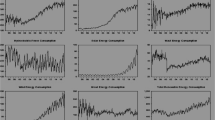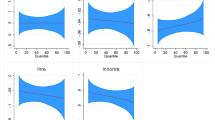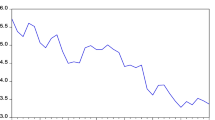Abstract
Nonrenewable energy sources maintain a substantial majority of Pakistan’s energy composition, exceeding 70%, posing challenges to achieving sustainability goals for a low-carbon economy. Recognizing this, the study determines the critical thresholds where renewable and nonrenewable energies affect more significantly on CO2 emission over the period from 1972Q1 to 2020Q4. The analysis begins by confirming the stationarity of the data through quantile unit root analysis, followed by an examination of long-term associations using quantile cointegration. For quantile-based impact assessments, we apply quantile regression. To uncover the direction of causality within quantiles, we use a novel approach, quantile causality analysis. Nonrenewable energy sources exhibit a long-term association at disaggregated levels, whereas the same is not true for renewable energy across the quantile distribution. Quantile regression results reveal that renewable energy sources positively impact CO2 emissions, with coal having the highest coefficient, followed by oil and gas, particularly in the upper quantiles, τ = {0.70–0.75}. However, renewable energy sources prove insignificant in decreasing CO2 emissions. Similarly, total energy consumption has a positive influence on CO2 emissions at extremely low quantiles, τ = {0.05–0.30} and high quantiles, τ = {0.65–0.90}, indicating sensitivity to extreme variations. The quantile causality analysis highlights a bidirectional causality relationship among CO2 emissions, total energy consumption, and both renewable and nonrenewable energy consumption across lower and upper quantiles. Policymakers should reallocate funds, provide subsidies, and introduce infrastructure development projects to reduce the burden on nonrenewable energy sources based on this quantile analysis.


Similar content being viewed by others
Data availability
Data sharing is not applicable to this article as no datasets were generated or analyzed during the current study.
References
Abbasi KR, Lv K, Radulescu M, Shaikh PA (2021) Economic complexity, tourism, energy prices, and environmental degradation in the top economic complexity countries: fresh panel evidence. Environ Sci Pollut Res 28:68717–68731
Abid N, Ceci F, Ahmad F, Aftab J (2022) Financial development and green innovation, the ultimate solutions to an environmentally sustainable society: evidence from leading economies. J Clean Prod 369:133223
Ahad, M., & Khan, W. (2016). Does globalization impede environmental quality in Bangladesh? The role of real economic activities and energy use.
Ahad M, Imran ZA (2023) The role of shadow economy to determine CO2 emission in Pakistan: evidence from novel dynamic simulated ARDL model and wavelet coherence analysis. Environ Dev Sustain 25(4):3043–3071
Ahmed K, Long W (2013) An empirical analysis of CO2 emission in Pakistan using EKC hypothesis. J Int Trade Law Policy 12(2):188–200
Ali U, Guo Q, Kartal MT, Nurgazina Z, Khan ZA, Sharif A (2022) The impact of renewable and non-renewable energy consumption on carbon emission intensity in China: fresh evidence from novel dynamic ARDL simulations. J Environ Manage 320:115782
Al-Mulali U, Ozturk I (2015) The effect of energy consumption, urbanization, trade openness, industrial output, and the political stability on the environmental degradation in the MENA (Middle East and North African) region. Energy 84:382–389
Apergis, N., Kuziboev, B., Abdullaev, I., & Rajabov, A. (2023). Investigating the association among CO2 emissions, renewable and non-renewable energy consumption in Uzbekistan: an ARDL approach. Environmental Science and Pollution Research 1–14.
Broock WA, Scheinkman JA, Dechert WD, LeBaron B (1996) A test for independence based on the correlation dimension. Economet Rev 15(3):197–235
Dickey, D. A., & Fuller, W. A. (1981). Likelihood ratio statistics for autoregressive time series with a unit root. Econ: J Econ Soc 1057–1072.
Dickey DA, Fuller WA (1981). Likelihood ratio statistics for autoregressive time series with a unit root. Econometrica: journal of the Econometric Society, 1057–1072.
Engle RF, Granger CW (1987) Co-integration and error correction: representation, estimation, and testing. Econ: J Econ Socs 251–276.
Engle RF, Granger CW (1987) Co-integration and error correction: representation, estimation, and testing. Econometrica, 251–276.
Farooq A, Anwar A, Ahad M, Shabbir G, Imran ZA (2021) A validity of environmental Kuznets curve under the role of urbanization, financial development index and foreign direct investment in Pakistan. J Econ Admin Sci.
Fatima T, Xia E, Ahad M (2018) An aggregate and disaggregate energy consumption, industrial growth and CO2 emission: fresh evidence from structural breaks and combined cointegration for China. Int J Energ Sect Manag
Galvao AF Jr (2009) Unit root quantile autoregression testing using covariates. J Econ 152(2):165–178
Govindaraju VC, Tang CF (2013) The dynamic links between CO2 emissions, economic growth and coal consumption in China and India. Appl Energy 104:310–318
Granger CW (1969) Investigating causal relations by econometric models and cross-spectral methods. Econ: J Econ Soc 424–438.
Granger, C. W. (1969). Investigating causal relations by econometric models and cross-spectral methods. Econ: J Econ Soc 424–438.
Huang W, Ortiz GGR, Kuo Y-L, Maneengam A, Nassani AA, Haffar M (2022) The non-linear impact of renewable energy and trade on consumption-based carbon emissions. Fuel 324:124423
IEA. Net zero by 2050: a roadmap for the global energy sector. https://www.iea.org/reports/net-zero-by-2050
Iqbal N, Abbasi KR, Shinwari R, Guangcai W, Ahmad M, Tang K (2021) Does exports diversification and environmental innovation achieve carbon neutrality target of OECD economies? J Environ Manage 291:112648
Iqbal S, Wang Y, Shaikh PA, Maqbool A, Hayat K (2022) Exploring the asymmetric effects of renewable energy production, natural resources, and economic progress on CO2 emissions: fresh evidence from Pakistan. Environ Sci Pollut Res 29(5):7067–7078
Jarque CM, Bera AK (1980) Efficient tests for normality, homoscedasticity and serial independence of regression residuals. Econ Lett 6(3):255–259
Johansen, S. (1991). Estimation and hypothesis testing of cointegration vectors in Gaussian vector autoregressive models. Econometrica 1551–1580.
Khan MI, Teng JZ, Khan MK (2020) The impact of macroeconomic and financial development on carbon dioxide emissions in Pakistan: evidence with a novel dynamic simulated ARDL approach. Environ Sci Pollut Res 27:39560–39571
Koenker R, Xiao Z (2004) Unit root quantile autoregression inference. J Am Stat Assoc 99(467):775–787
Liu Y, Kumail T, Ali W, Sadiq F (2019) The dynamic relationship between CO2 emission, international tourism and energy consumption in Pakistan: a cointegration approach. Tourism Review.
Madni GR, Anwar MA, Ahmad N (2021) Socio-economic determinants of environmental performance in developing countries. Journal of the Knowledge Economy 1–12.
Magazzino C (2017). Economic growth, CO2 emissions and energy use in the South Caucasus and Turkey: a PVAR analyses. International Energy Journal 16(4).
Magazzino C, Bekun FV, Etokakpan MU, Uzuner G (2020) Modeling the dynamic nexus among coal consumption, pollutant emissions and real income: empirical evidence from South Africa. Environ Sci Pollut Res 27:8772–8782
Naeem MA, Nguyen TTH, Karim S, Lucey BM (2023) Extreme downside risk transmission between green cryptocurrencies and energy markets: the diversification benefits. Financ Res Lett 58:104263
Nham NTH (2022) An application of a TVP-VAR extended joint connected approach to explore connectedness between WTI crude oil, gold, stock and cryptocurrencies during the COVID-19 health crisis. Technol Forecast Soc Chang 183:121909
Omri A, Euchi J, Hasaballah AH, Al-Tit A (2019) Determinants of environmental sustainability: evidence from Saudi Arabia. Sci Total Environ 657:1592–1601
Pata UK, Kartal MT (2023) Impact of nuclear and renewable energy sources on environment quality: testing the EKC and LCC hypotheses for South Korea. Nucl Eng Technol 55(2):587–594
Phillips PC, Perron P (1988) Testing for a unit root in time series regression. Biometrika 75(2):335–346
Raihan A, Tuspekova A (2022) Toward a sustainable environment: nexus between economic growth, renewable energy use, forested area, and carbon emissions in Malaysia. Res Conserv Recycl Adv 15:200096. https://doi.org/10.1016/j.rcradv.2022.200096
Rjoub H, Odugbesan JA, Adebayo TS, Wong WK (2021) Sustainability of the moderating role of financial development in the determinants of environmental degradation: evidence from Turkey. Sustainability 13(4):1844
Saidi K, Omri A (2020) The impact of renewable energy on carbon emissions and economic growth in 15 major renewable energy-consuming countries. Environ Res 186:109567
Salari M, Javid RJ, Noghanibehambari H (2021) The nexus between CO2 emissions, energy consumption, and economic growth in the US. Econ Anal Policy 69:182–194
Shin Y, Yu B, Greenwood-Nimmo M (2014) Modelling asymmetric cointegration and dynamic multipliers in a nonlinear ARDL framework. Festschrift in honor of Peter Schmidt: Econometric methods and applications, 281–314.
Tahir M, Hayat A, Burki U (2022) Determinants of environmental degradation in Saudi Arabia: exploring the unexplored. Int J Energ Sect Manage 16(1):129–148
Troster V (2018) Testing for Granger-causality in quantiles. Economet Rev 37(8):850–866
Voumik LC, Ridwan M, Rahman MH, Raihan A (2023) An investigation into the primary causes of carbon dioxide releases in Kenya: does renewable energy matter to reduce carbon emission? Renewable Energy Focus 47:100491
Xiao Z (2009) Quantile cointegrating regression. J Econ 150(2):248–260
Yahya F, Lee C-C (2023) Disentangling the asymmetric effect of financialization on the green output gap. Energy Economics 125:106899
Zmami M, Ben-Salha O (2020) An empirical analysis of the determinants of CO2 emissions in GCC countries. Int J Sust Dev World 27(5):469–480
Author information
Authors and Affiliations
Contributions
Mr. MA is the sole author of this manuscript. He has carried all the work by himself.
Corresponding author
Ethics declarations
Ethics approval and consent to participate
Not applicable.
Consent for publication
Not applicable.
Competing interests
The authors declare no competing interests.
Additional information
Responsible Editor: Roula Inglesi-Lotz
Publisher's Note
Springer Nature remains neutral with regard to jurisdictional claims in published maps and institutional affiliations.
Rights and permissions
Springer Nature or its licensor (e.g. a society or other partner) holds exclusive rights to this article under a publishing agreement with the author(s) or other rightsholder(s); author self-archiving of the accepted manuscript version of this article is solely governed by the terms of such publishing agreement and applicable law.
About this article
Cite this article
Ahad, M. Quantile-based assessment of energy-CO2 emission nexus in Pakistan. Environ Sci Pollut Res 31, 7345–7363 (2024). https://doi.org/10.1007/s11356-023-31699-8
Received:
Accepted:
Published:
Issue Date:
DOI: https://doi.org/10.1007/s11356-023-31699-8
Keywords
- Renewable energy
- Nonrenewable energy
- CO2 emission
- Quantile cointegration
- Quantile regression
- Quantile causality




